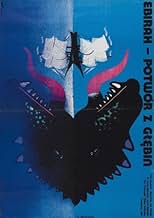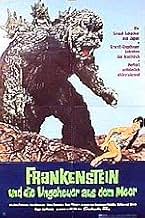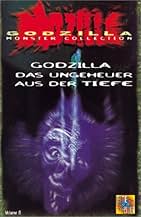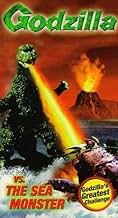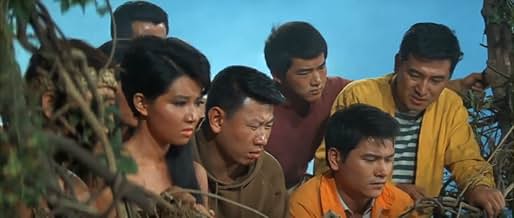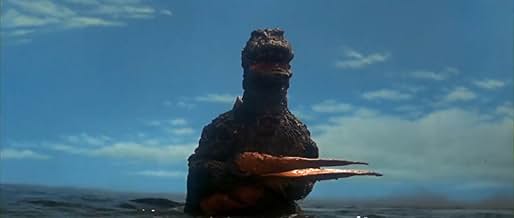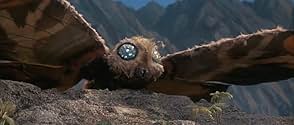Ebirah, o Terror dos Abismos
Título original: Gojira · Ebira · Mosura Nankai no daikettô
AVALIAÇÃO DA IMDb
5,5/10
6,9 mil
SUA AVALIAÇÃO
Adicionar um enredo no seu idiomaFour men searching for one's brother are shipwrecked on Letchi Island, where they encounter Godzilla, a monstrous lobster, and terrorists who have enslaved the natives of Infant Island.Four men searching for one's brother are shipwrecked on Letchi Island, where they encounter Godzilla, a monstrous lobster, and terrorists who have enslaved the natives of Infant Island.Four men searching for one's brother are shipwrecked on Letchi Island, where they encounter Godzilla, a monstrous lobster, and terrorists who have enslaved the natives of Infant Island.
Avaliações em destaque
This movie was set on an island, where all the mayhem, action, destruction, battles and drama take place. A group of teenagers go sailing in search for a long lost brother and gets shipwrecked on an island. The island inhabitants are a band of people called the Red Bamboo, who are secretly making nuclear bombs in order to conquer the world. Islanders from Infant Island were kidnapped as slaves and the teenagers try to do everything they can to save the islanders and stop the terrorists. To add to the excitement, who would have guessed Godzilla would be seen sleeping in a cave on the island and that an over-sized Shrimp (Lobster or Crab in some reviews) is supposed to be guarding the island? A lot of humor in this movie, especially the lines "I thought you studied science?" with an answer "But I didn't pass the first year, one thing's for sure."
A pretty native girl, played by Kumi Mizuno, is attracted by Godzilla, who gave a little love relationship to her-a love relationship more associated with King Kong (since the story of this movie was originally written for King Kong). Masaru Sato's music score is catchy and Jun Fukuda did a great directing job. Shinichi Sekizawa gave us an exciting story and Eiji Tsuburaya gave us cool special effects. And, Mothra has a cameo in this movie and her tiny twin priestesses also made an appearance.
Overall, it is a unique and exciting Godzilla entry with plenty of monster appearances and action, which is a plus!
Grade A
A pretty native girl, played by Kumi Mizuno, is attracted by Godzilla, who gave a little love relationship to her-a love relationship more associated with King Kong (since the story of this movie was originally written for King Kong). Masaru Sato's music score is catchy and Jun Fukuda did a great directing job. Shinichi Sekizawa gave us an exciting story and Eiji Tsuburaya gave us cool special effects. And, Mothra has a cameo in this movie and her tiny twin priestesses also made an appearance.
Overall, it is a unique and exciting Godzilla entry with plenty of monster appearances and action, which is a plus!
Grade A
Of all the Japanese monster films that came out from the mid Fifties to the mid Seventies, Godzilla Versus The Sea Monster is the only one that seems to have taken a political stand on anything. The Japanese for obvious reasons are big on nuclear disarmament. This film involves Godzilla and two other giant monsters involved with the Red Bamboo who are a group conducting nuclear experiments on a deserted south sea island. Of course there was no such a group as the Red Bamboo, but the power across the Sea of Japan did have a Red Guard who were pretty active in those days. I think that was another political statement that Godzilla Versus The Sea Monster was making.
Anyway some 20 somethings who were involved in a dance marathon which opened the film, commandeer a boat that was to be the getaway vehicle of a bank robber to search for the brother of one of them who set sail southeast and was not heard from.
It's there that a storm washes them ashore on the island of the Red Bamboo. These dastardly folks are not only conducting nuclear experiments, they're making heavy water to use as nuclear fuel, but are using slave labor. The slaves are being taken from the island that Mothra resides, but he's sleeping and the natives are doing their best to arouse their friend and protector.
To discourage escape in the meantime, the island is guarded by Ebirah a giant lobster monster. The Red Bamboo controls him by means of the nectar of some exotic tropical fruit that acts as a tranquilizer.
When our heroes arrive, they discover that Godzilla is in some kind of coma asleep on the island. Needing an ally they look to get him awake to start doing his thing. Of course all three monsters battle it out in the end.
This particular all star monster spectacular is a cut above the others for its political statement wrapped up in the dopey way these films play. But I have to admit a soft spot in my heart for them.
Anyway some 20 somethings who were involved in a dance marathon which opened the film, commandeer a boat that was to be the getaway vehicle of a bank robber to search for the brother of one of them who set sail southeast and was not heard from.
It's there that a storm washes them ashore on the island of the Red Bamboo. These dastardly folks are not only conducting nuclear experiments, they're making heavy water to use as nuclear fuel, but are using slave labor. The slaves are being taken from the island that Mothra resides, but he's sleeping and the natives are doing their best to arouse their friend and protector.
To discourage escape in the meantime, the island is guarded by Ebirah a giant lobster monster. The Red Bamboo controls him by means of the nectar of some exotic tropical fruit that acts as a tranquilizer.
When our heroes arrive, they discover that Godzilla is in some kind of coma asleep on the island. Needing an ally they look to get him awake to start doing his thing. Of course all three monsters battle it out in the end.
This particular all star monster spectacular is a cut above the others for its political statement wrapped up in the dopey way these films play. But I have to admit a soft spot in my heart for them.
This is actually on of my favourite Godzilla films. While on one hand it has one of the worst enemy monsters, Ebira (although it also has Mothra, but he only appears at the end and doesn't really do anything) it also has a neat story. It's not as cool as the original, but I think it sure as hell beats the cheezy alien stories which are so ridiculous and unbelievable that even their cheeze value is threatened. As well, most Godzilla movies spend *way* too much time and focus on the monsters fighting and rampaging (Godzilla vs. Gigan is a perfect example of this), but this one had more of a plot. The takeover didn't seem as implausible and it was more tongue in cheek. It's also one of the best dub-jobs I've *ever* seen in a Godzilla movie (or any of the other similar ones).
Overall: this is one of the more fun Godzilla films. It's still silly, but in an enjoyable way. It's not ruined by being overly stupid and it's cheeze factor is definitely amusing. 6/10.
Overall: this is one of the more fun Godzilla films. It's still silly, but in an enjoyable way. It's not ruined by being overly stupid and it's cheeze factor is definitely amusing. 6/10.
This is the second Godzilla movie to this point that wasn't directed by Ishiro Honda (first being Godzilla Raids Again), and was directed by Jun Fukuda. Fukuda chose Masaru Sato to compose the music instead of Akira Ifukube, and overall contributes to the lighter touch. Shinichi Sekizawa's screenplay continues on the trend of humanizing the monsters, and Ebira's pose before the battle is a caricature of the then popular professional wrestler Toyonobori, and Godzilla rubbing his index finger on his nose is a caricature of Yuzo Kayama's character in Wakadaisho series which usually played at same time as the Godzilla movies as a double feature. The cinematography is noticeably brighter and the characters are also bit more easy going than Honda's version of Godzilla movies.
Ryota (Tetsu Watanabe) who lost his brother in the South Pacific in a fishing boat accident believes in the prediction made by a spiritual medium in Mt. Osore that his brother is still alive. He comes out to Tokyo to look for a way to get to his brother. There he meets few college students and later a thief named Yoshimura (Akira Takarada) in a sailboat they've snuck into. While everyone's asleep, Ryota sets sail to the south pacific to search for his brother. In a stormy sea the sailboat runs aground on an island occupied by a gang who calls themselves the "Red Bamboo". Red Bamboo is kidnapping the residents of Infant Island (Mothra Island) as slave labor to further their cause. Dayo (Kumi Mizuno) a girl from Infant Island escapes into the jungle and meets Ryota and Yoshimura's crew. There they hide in a cave to escape Red Bamboo's pursuit. Unbeknownst to them, that cave contained a hibernating Godzilla. Yoshimura comes up with a novel plan to wake Godzilla and turn it against the Red Bamboo.
In this movie, the fairies that talks to Mothra also changed from The Peanuts (Emi and Yumi Ito) to another twins Pair Bambi (Yuko and Yoko Okada - born 4/19/1944 Nagoya Japan). They were already 15 year veteran in the show business when they stared in this movie. Originally, Noriko Takahashi was to play the part of Dayo, but fell ill to appendicitis so was changed to Kumi Mizuno at the last minute. Mizuno who was 29 at the time played the role written for a 19 year old girl. Takahashi 6 month earlier played a similar role in Tsuburaya Production's Ultra Q series as a native girl who lost her brother to a giant octopus.
In the mid to late sixties, Godzilla movie started to slide to a lighter stories. This movie took the formula one step further from the previous Godzilla move the "Monster Zero", and continues the humanization of Godzilla and the monsters. Jun Fukuda's directing isn't up to par with Honda's and the props look cheezy by comparison which took away from the story, but most likely the movie was intended for kids and this was part of their production plan. The good in this movie was Akira Takarada and Kumi Mizuno that brought character to acting. Overall the movie succeeded because these two characters kept the focus. Good entertainment from the '60s Toho studio.
Ryota (Tetsu Watanabe) who lost his brother in the South Pacific in a fishing boat accident believes in the prediction made by a spiritual medium in Mt. Osore that his brother is still alive. He comes out to Tokyo to look for a way to get to his brother. There he meets few college students and later a thief named Yoshimura (Akira Takarada) in a sailboat they've snuck into. While everyone's asleep, Ryota sets sail to the south pacific to search for his brother. In a stormy sea the sailboat runs aground on an island occupied by a gang who calls themselves the "Red Bamboo". Red Bamboo is kidnapping the residents of Infant Island (Mothra Island) as slave labor to further their cause. Dayo (Kumi Mizuno) a girl from Infant Island escapes into the jungle and meets Ryota and Yoshimura's crew. There they hide in a cave to escape Red Bamboo's pursuit. Unbeknownst to them, that cave contained a hibernating Godzilla. Yoshimura comes up with a novel plan to wake Godzilla and turn it against the Red Bamboo.
In this movie, the fairies that talks to Mothra also changed from The Peanuts (Emi and Yumi Ito) to another twins Pair Bambi (Yuko and Yoko Okada - born 4/19/1944 Nagoya Japan). They were already 15 year veteran in the show business when they stared in this movie. Originally, Noriko Takahashi was to play the part of Dayo, but fell ill to appendicitis so was changed to Kumi Mizuno at the last minute. Mizuno who was 29 at the time played the role written for a 19 year old girl. Takahashi 6 month earlier played a similar role in Tsuburaya Production's Ultra Q series as a native girl who lost her brother to a giant octopus.
In the mid to late sixties, Godzilla movie started to slide to a lighter stories. This movie took the formula one step further from the previous Godzilla move the "Monster Zero", and continues the humanization of Godzilla and the monsters. Jun Fukuda's directing isn't up to par with Honda's and the props look cheezy by comparison which took away from the story, but most likely the movie was intended for kids and this was part of their production plan. The good in this movie was Akira Takarada and Kumi Mizuno that brought character to acting. Overall the movie succeeded because these two characters kept the focus. Good entertainment from the '60s Toho studio.
Yes. I'll admit it . This is a bad movie. A bad movie that I've watched over and over and over and over again! It is weird how much I like this movie. You could say I like it ironically, but not really, because I believe it has a type of charm that I find intentional. The monster fights are fun, and I like the plot. I totally understand people that hate this entry in the series, but I find it to be one of the most fun Godzilla movies out there!
On my Top 10 Godzilla Films list, it is actually included. Here's the list: 1.Gojira 2.Godzilla vs. Mechagodzilla 3.Godzilla vs. King Ghidorah 4.Godzilla: Final Wars 5.Mothra vs. Godzilla 6.Godzilla vs. Destroyah 7.Godzilla vs. Spacegodzilla 8.Godzilla, Mothra, and King Ghidorah: Giant Monsters All Out Attack 9.Ghidorah: The Three-Headed Monster 10.(this film.)
On my Top 10 Godzilla Films list, it is actually included. Here's the list: 1.Gojira 2.Godzilla vs. Mechagodzilla 3.Godzilla vs. King Ghidorah 4.Godzilla: Final Wars 5.Mothra vs. Godzilla 6.Godzilla vs. Destroyah 7.Godzilla vs. Spacegodzilla 8.Godzilla, Mothra, and King Ghidorah: Giant Monsters All Out Attack 9.Ghidorah: The Three-Headed Monster 10.(this film.)
Você sabia?
- CuriosidadesThis film was originally written to star King Kong, as Rankin/Bass Productions had provided Toho with the license to the character in order to produce a tie-in film for Toei's animated TV series King Kong (1966), which they co-produced. However, Rankin/Bass rejected the original treatment, as they wanted director Ishirô Honda to helm the film. Toho insisted on Jun Fukuda and after Rankin/Bass backed out, Toho decided to replace King Kong with Godzilla. Toho and Rankin/Bass would then go on to co-produce A Fuga de King-Kong (1967), a film that was more in line with what Rankin/Bass wanted.
- Erros de gravaçãoAt the end of the film, as Mothra flies back to Infant Island, the large net she is carrying with her feet with the humans inside it is missing.
- Cenas durante ou pós-créditosFor the Columbia/Tri-Star U.S. DVD release of the film, which uses the original uncut Japanese version of it, its English-language credits list the noted composer Masaru Satô as "Mararu Sato."
- Versões alternativasThe Mystery Science Theater 3000 version of the film featured a Film Ventures-lensed print of it that used a different title sequence made up of clips from the next film in the Godzilla series, O Filho de Godzilla (1967).
- ConexõesEdited into Monstrolândia (1969)
Principais escolhas
Faça login para avaliar e ver a lista de recomendações personalizadas
- How long is Ebirah, Horror of the Deep?Fornecido pela Alexa
Detalhes
- Data de lançamento
- País de origem
- Idioma
- Também conhecido como
- Ebirah, Horror of the Deep
- Empresa de produção
- Consulte mais créditos da empresa na IMDbPro
Bilheteria
- Orçamento
- US$ 1.200.000 (estimativa)
- Tempo de duração1 hora 27 minutos
- Mixagem de som
- Proporção
- 2.35 : 1
Contribua para esta página
Sugerir uma alteração ou adicionar conteúdo ausente

Principal brecha
By what name was Ebirah, o Terror dos Abismos (1966) officially released in India in English?
Responda

